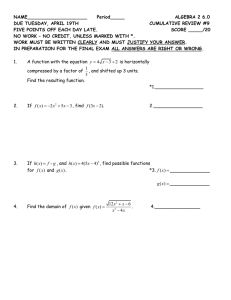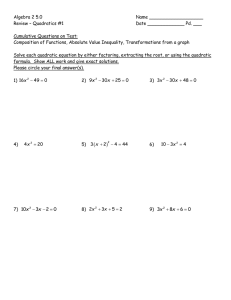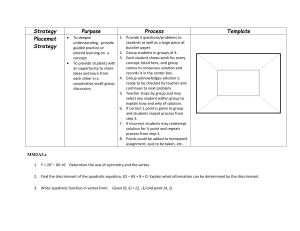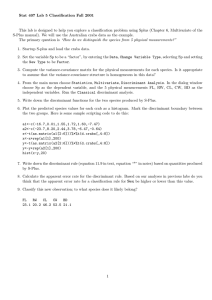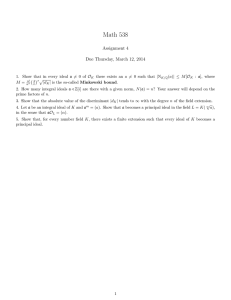Alternative Method for Determining Industrial Bond Ratings
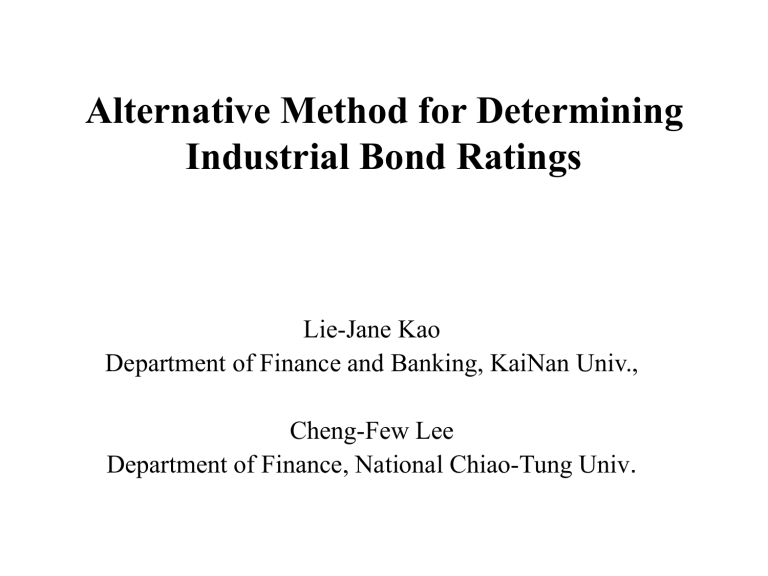
Alternative Method for Determining
Industrial Bond Ratings
Lie-Jane Kao
Department of Finance and Banking, KaiNan Univ.,
Cheng-Few Lee
Department of Finance, National Chiao-Tung Univ .
Financial-ratio based Credit-Scoring Models
The combination of several weighted financial ratios to provide index/indices that classifies business’s failure or bond ratings.
Classes of Credit Scoring Model
(Altman and Saunder, 1998)
• (i) The linear probability model,
• (ii) The logit model,
• (iii) The probit model,
• (iv) The discriminant analysis model.
Altman’s Z-score model (1968)
Z = 0.012X
1
+ 0.014X
2
+ 0.033X
3
+ 0.006X
4
+0.999X
5
• X
1
=working capital/total assets,
• X
2
=retained earnings/total assets,
•
X
3
=earnings before interest and taxes/total assets,
•
X
4
=market value equity/book value of total liabilities,
•
X
5
=sales/total assets.
Financial Ratios Selection
• A list of 22 potentially helpful ratios are chosen on the basis of their popularity in the literature and their potential relevancy to the study (Altman, 2000).
• Later, 27 financial ratios that include measures found in other studies thought to be potentially helpful as well in providing statistical evidence of impending failures are listed (Altman, 2000).
Altman’s Zeta model (1977)
• Earnings before taxes and interest/Total assets;
•
Earnings before taxes and interest/Total Interest
Payments;
•
Retained earnings since inception/Total assets;
•
Market value of equity/Total capital;
•
Current ratio;
•
The standard error of estimate around a five to ten-year trend in X1;
•
Firms' total assets.
Useful Financial Ratios (Chen ,1981)
A summary of 25 predictive studies shows there is a total of 65 financial ratios, 41 of these are considered useful; yet, every study cited a different set of ratios as being the most effective indication of firm’s failure or bond’s rating.
The design of a credit-scoring model involves
• Principle I: Meaningful financial variables selection,
• Principle II: Classification Accuracy,
( Basel Committee on Banking Supervision, 2005)
Stepwise Discriminant Analysis
(Pinches and Mingo, 1973, 1975)
• Financial variable selection: Factor analysis
(Principle component analysis);
• Bond classification: Multiple discriminant analysis.
Stepwise Discriminant Analysis
Financial variable selection
35 financial variables are classified into 7 factors:
(1) Size;
(2) Leverge;
(3) Long-term capital intensiveness;
(4) Short-term capital intensiveness;
(5) Return on investment;
(6) Earning stability;
(7) Debt coverage.
Stepwise Discriminant Analysis
Bond classification
Three discriminant functions Y
1
, Y
2
, Y
3 are obtained using multiple discriminant analysis (MDA):
• Y
1
• Y
2
• Y
3
: subordination (90%)
: net income+interest/interest (5%)
: issue size (4%)
The percentage correctly predicted is 69.70%
Financial Variable Selection
•
Principle component analysis : a statistical tool to group correlated financial variables into a few linear functions that account for the majority of the variance by the original set of financial variables, i.e., to extract a few components that retain a maximium of information contained in the original data, or, have the maximal explanatory power .
Bond Classification
• Multiple discriminant analysis : a statistical tool to find linear functions of financial variables that maximize the between group variance while minimizing the within group variance among these variables, so that different bond rating groups can be distinguished, i.e., to extract a few components that have the maximal discriminant power .
Maximization of Explanatory Power
• Financial variables
X =( X
1
,…,
X p
)
,
• The principal components Y
1
=
1
X , …, Y u
=
u
X
• If the first i -1 principle components are determined, Y i is determined by choosing
i that maximizes the variance of Y i
, i.e., var ( Y i
i
i
is the variance-covariance matrix of the whole population. The maximization is subject to the constraints
j
i
=0 for all j < i and
i
i
=1.
Maximization of Discriminant Power
• Financial variables X=(X
1
,…, X p
)
,
• k populations with common variance-covariance
,
• The discriminant functions D
1
=
1
-
1/2
X , …, D u
=
u
-
1/2
X,
•
If the first i-1 discriminant functions are determined, D i determined by choosing
i that maximizes the ratio comparing the variability between the groups to that is within the groups , i.e.,
i
Σ
1 / 2 j k
1 w i
j
j
Σ
1 / 2 i
(2)
The maximization is subject to the constraints all j<i and
i
i
=1.
j
i
=0 for
Two Conflicting Objectives
Theorem: If a set of r linear components M
1
1/2 X
, …,
M r
=
r
=
1
-
-1/2
X , r
min( k -1, p ), that maximizes
(1) and (2) simultaneously, subject to the constraints
i
j
0 for all j < i and
i
i
=1, exists, then the two matrices
Σ
1 / 2
j k
1 w i
j
j
Σ
1 / 2 and
share the same set of eigenvectors.
A Compromise Solution
• Pareto efficient solution: Achieved level of any of the objectives cannot be improved without worsening the achieved level of any other objective (Tamiz, 1996,
1998).
Goal Programming
• Form of multi-objective optimization,
• Ignizio in the 1970’s,
• Each of the objectives is given an aspiration level and unwanted deviation , the unwanted deviations from these aspiration levels are minimized in an achievement function .
Goal Programming
• Aspiration Level - Specific value associated with the desired or acceptable level of the objective,
• Goal Deviation - Difference between the aspiration level and what we accomplish w.r.t. the objective,
• Achievement Function - To measure the achievement of the objective.
Three Goal Programming Variants
• Weighted Goal Programming: Minimize weighted sum of goal deviations,
• Lexicographic Goal Programming: Minimize an ordered set of goal deviations,
• Minmax Goal Programming: Minimize the worst deviation.
Formulation of MINIMAX GP
...
be the eigenvalues of
0
A
1
=
Σ
1 / 2
j k
1 w i
j
j
Σ
1 / 2
1
2
...
p
>0
A
2
=
, respectively.
Formulation of MINIMAX GP
•
Achievement function :
Min D
•
Constraints : u
1
D u
2
D g
1
( g
2
( h
1
( h j
(
s
)+ u
1
= s
)+ u
2
=
s
)=
s
s
s
s
* s
-1=0
)=0 for j < s u
1
, u
2 and represent the under achievement of the target values
s
, respectively.
Emperical Analysis
• A total of 132 industrial corporate bonds rated B, Ba,
Baa, A, Aa based on Moody’s ratings from January 1,
1967 to December 31, 1968 (Pinches and Mingo,
1973).
Comparing Four Multivariate Techniques
• Principle Component Analysis,
• Multiple Discriminant Analysis,
• Stepwise Discriminant Analysis,
• MOP Discriminant Analysis.
Principle Component Analysis
Principle Component Analysis
Multiple Discriminant Analysis
Multiple Discriminant Analysis
Stepwise Discriminant Analysis
Stepwise Discriminant Analysis

